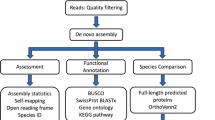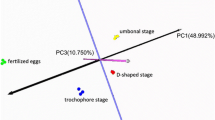Abstract
Pleurochrysis haptonemofera is a unicellular marine coccolithophorid that has calcified scales, coccoliths, on the cell surface. Some coccolithophorids including P. haptonemofera have a coccolith-bearing stage and a naked stage in their life cycles. To characterize genes involved in the coccolithogenesis, we generated a total of 9550 expressed sequence tags (EST) from a normalized cDNA library that was prepared using both coccolith-bearing cells (C-cells) and naked cells (N-cells), constructed a cDNA macroarray using the EST clones, and then analyzed the gene expression specificity in C-cells and N-cells. When cDNA clones whose expression ratio exceeded 3-fold were selected, as many as 180 clones were identified as C-cell-specific ones, while only 12 were found to be N-cell-specific ones. These clones were sequenced, assembled, and homology-searched against a public nonredundant protein database. As a result, they were grouped into 54 C-cell-specific and 6 N-cell-specific genes, and 59% and 50% of these genes exhibited significant similarity to those of other known proteins, respectively. To assess mRNA expression further, Northern hybridization was performed for 12 of the C-cell-specific genes and one of the N-cell-specific ones. These clones, together with the new cDNA macroarray, will provide a powerful tool for the future genome-wide functional analysis of uncharacterized genes related to the regulation of the calcification and life cycle of coccolithophorids.




Similar content being viewed by others
References
Asamizu E, Nakamura Y, Sato S, Fukuzawa H, Tabata S (1999) A large scale structural analysis of cDNAs in a unicellular green alga, Chlamydomonas reinhardtii. I. Generation of 3433 non-redundant expressed sequence tags. DNA Res 6, 369–373
Bonaldo MF, Lennon G, Soares MB (1996) Normalization and substitution: two approaches to facilitate gene discovery. Genome Res 6, 791–806
Dionisio-Sese ML, Miyachi S (1992) The effect of sodium chloride on carbonic anhydrase activity in marine microalgae. J Phycol 28, 619–624
Fichtinger-Shepman AMJ, Kamerling JP, Vliegenthart JFG (1981) Composition of a methylated, acidic polysaccharide associated with coccoliths of Emiliania huxleyi (Lohmann) Kamptner. Carbohydr Res 69, 181–189
Fresnel J (1986) Nouvelles observations sur une Coccolithacée rare: Cruciplacolithus neohelis (McIntyre and Bé) Reinhadt (Prymnesiophyceae). Protistologica 22, 193–204
Fujiwara S, Kawachi M, Minaka N, Inouye I (2001) Molecular phylogeny of the Haptophyta based on the rbcL gene and sequence variation in the spacer region on the rubisco operon. J Phycol 37, 121–129
Hirokawa H, Fujiwara S, Tsuzuki M (2005) Three types of acidic polysaccharides associated with coccolith of Pleurochrysis haptonemofera: comparison of the biochemical characteristics with those of P. carterae and analysis using fluorescein-isothiocyanate-labeled lectins. Mar Biotechnol 7, 634–644
Inouye I, Pienaar RN (1984) New observations on the coccolithophorid Umbilicosphaera sibogae var. foliosa (Prymnesiophyceae) with reference to cell covering, cell structure and flagellar apparatus. Br Phycol J 19, 357–369
Kono M, Hayashi N, Samata T (2000) Molecular mechanism of the nacreous formation in Pinctada maxima. Biochem Biochys Res Commun 269, 213–218
Leadbeater BSC (1994) "Cell coverings". In The Haptophyte Algae. Green JC, Leadbeater BSC, eds. (Oxford: Clarendon Press) pp 23–46
Lin S, Corstjens PLAM (2002) Molecular cloning and expression of the proliferating cell nuclear antigen gene from the coccolithophorid Pleurochrysis carterae (Haptophyceae). J Phycol 38, 164–173
Marsh ME (2003) Regulation of CaCO3 formation in coccolithophores. Comp Biochem and Physiol B 136, 743–754
Marsh ME, Chang DK, King GC (1992) Isolation and characterization of a novel acidic polysaccharide containing tartrate and glyoxylate residues from the mineralized scales of a unicellular coccolithophorid alga Pleurochrysis carterae. J Biol Chem 267, 20507–20512
Miyamoto H, Miyashita T, Okushima M, Nakano S, Morita T, Matsushiro A (1996) A carbonic anhydrase from the nacreous layer in oyster pearls. Proc Natl Acad Sci USA 93, 9657–9660
Nguyen B, Bowers RM, Wahlund TM, Read BA (2005) Suppressive subtractive hybridization of and differences in gene expression content of calcifying and noncalcifying cultures of Emiliania huxleyi strain 1516. Appl Environ Microbiol 71, 2564–2575
Nikaido I, Asamizu E, Nakajima M, Nakamura Y, Saga N, Tabata S (2000) Generation of 10,154 expressed sequence tags from a leafy gametophyte of a marine red alga, Porphyra yezoensis. DNA Res 7, 223–227
Obayashi T, Okegawa T, Sasaki-Sekimoto Y, Shimada H, Masuda T, Asamizu E, Nakamura Y, Shibata D, Tabata S, Takamiya K, Ohta H (2004) Distinctive features of plant organs characterized by global analysis of gene expression in Arabidopsis. DNA Res 11, 11–25
Oyama Y, Izumo A, Fujiwara S, Shimonaga T, Nakamura Y, Tsuzuki M (2006) Granule-bound starch synthase cDNA in Chlorella kessleri 11h: cloning and regulation of expression by CO2 concentration. Planta 224, 646–654
Quinn P, Bowers RM, Zhang X, Wahlund TM, Fanelli MA, Olszova D, Read BA (2006) cDNA microarrays as a tool for identification of biomineralization proteins in the coccolithophorid Emiliania huxleyi (Haptophyta). Appl Environ Microbiol 72, 5512–5526
Quiroga O, González EL (1993) Carbonic anhydrase in the chloroplast of a coccolithophorid (Prymnesiophyceae). J Phycol 29, 321–324
Sasaki Y, Asamizu E, Shibata D, Nakamura Y, Kaneko T, Awai K, Amagai M, Kuwata C, Tsugane T, Masuda T, Shimada H, Takamiya K, Ohta H, Tabata S (2001) Monitoring of methyl jasmonate-responsive genes in Arabidopsis by cDNA macroarray: self-activation of jasmonic acid biosynthesis and crosstalk with other phytohormone signaling pathways. DNA Res 8, 153–161
Soto AR, Zheng H, Shoemaker D, Rodriguez J, Read BA, Wahlund TM (2006) Identification and preliminary characterization of two cDNAs encoding unique carbonic anhydrases from the marine alga Emiliania huxleyi. Appl Environ Microbiol 72, 5500–5511
Takahashi J, Fujiwara S, Kikyo M, Hirokawa Y, Tsuzuki M (2002) Discrimination of the cell surface of the coccolithophorid Pleurochrysis haptonemofera from light scattering and fluorescein-isothiocyanate-labeled lectin staining measured by flow cytometry. Mar Biotechnol 4, 94–101
van der Wal P, de Jong EW, Westbroek P, de Bruijin WC, Mulder-Stapel AA (1983) Polysaccharide localization, coccolith formation and Golgi dynamics in the coccolithophorid Hymenomonas carterae. J Ultrastr Res 85, 139–158
Wahlund TM, Hadaegh AR, Clark R, Nguyen B, Fanelli M, Read BA (2004a) Analysis of expressed sequence tags from calcifying cells of the marine coccolithophorid, Emiliania huxleyi. Mar Biotechnol 6, 278–290
Wahlund TM, Zhang X, Read BA (2004b) EST expression profiles from calcifying and non-calcifying cultures of Emiliania huxleyi. Micropaleontol 50 (Suppl), 145–155
Westbroek P, Young JR, Linschooten K (1989) Coccolith production (biomineralization) in the marine alga Emiliania huxleyi. J Protozool 36, 368–373
Acknowledgments
The authors thank Drs. I. Inouye and M. Kawachi of Tsukuba University, Japan, for kindly providing the P. haptonemofera cells and the scanning electron micrographs; Mr. T. Suzuki of the Kazusa DNA Research Institute for the excellent technical support; and Dr. M. Yamamoto of Tokyo University of Pharmacy and Life Sciences, Japan, for the helpful comments. This work was supported by Grants-in-Aid from the Ministry of Education, Science, Sports and Culture, Japan (13640657, 13740463 and 13874112); the Promotion and Mutual Aid Corporation for Private Schools; the Kazusa DNA Research Institute Foundation; and a Sasakawa Scientific Research Grant from The Japan Science Society to Y. H.
Author information
Authors and Affiliations
Corresponding author
Additional information
Shoko Fujiwara and Yasutaka Hirokawa contributed equally to this work.
Rights and permissions
About this article
Cite this article
Fujiwara, S., Hirokawa, Y., Takatsuka, Y. et al. Gene Expression Profiling of Coccolith-Bearing Cells and Naked Cells in Haptophyte Pleurochrysis haptonemofera with a cDNA Macroarray System. Mar Biotechnol 9, 550–560 (2007). https://doi.org/10.1007/s10126-007-9039-8
Received:
Accepted:
Published:
Issue Date:
DOI: https://doi.org/10.1007/s10126-007-9039-8




